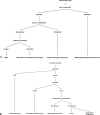Uncommon Glioneuronal Tumors: A Radiologic and Pathologic Synopsis
- PMID: 35512827
- PMCID: PMC9575428
- DOI: 10.3174/ajnr.A7465
Uncommon Glioneuronal Tumors: A Radiologic and Pathologic Synopsis
Abstract
Glioneuronal tumors are characterized exclusively by neurocytic elements (neuronal tumors) or a combination of neuronal and glial features (mixed neuronal-glial tumors). Most of these tumors occur in young patients and are related to epilepsy. While ganglioglioma, dysembryoplastic neuroepithelial tumor, and desmoplastic infantile tumor are common glioneuronal tumors, anaplastic ganglioglioma, papillary glioneuronal tumor, rosette-forming glioneuronal tumor, gangliocytoma, and central neurocytoma are less frequent. Advances in immunohistochemical and molecular diagnostics have improved the characterization of these tumors and favored the description of variants and new subtypes, some not yet classified by the World Health Organization. Not infrequently, the histologic findings of biopsies of glioneuronal tumors simulate low-grade glial neoplasms; however, some imaging findings favor the correct diagnosis, making neuroimaging essential for proper management. Therefore, the aim of this review was to present key imaging, histopathology, immunohistochemistry, and molecular findings of glioneuronal tumors and their variants.
© 2022 by American Journal of Neuroradiology.
Figures










References
-
- Gatto L, Franceschi E, Nunno VD, et al. . Glioneuronal tumors: clinicopathological findings and treatment options. Future Neurol 2020;15:FNL47 10.2217/fnl-2020-0003 - DOI
-
- Osborn AG, Hedlund GL, Salzman KL. Osborn’s Brain: Imaging, Pathology, and Anatomy. 2nd ed. Elsevier; 2017
-
- Chougule M. Neuropathology of Brain Tumors with Radiologic Correlates. Springer-Verlag; 2020
Publication types
MeSH terms
LinkOut - more resources
Full Text Sources
Medical
